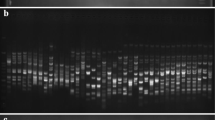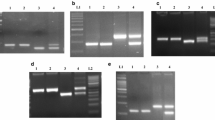Abstract
The main objective of the present study was to identify mitochondrial DNA based marker, which can distinguish male sterile and fertile counterparts of the cytoplasmic male sterile (CMS) lines used in production of rice hybrids. Amplified fragment length polymorphism (AFLP) analysis in CMS lines: IR58025A & IR62829A and their respective maintainers: IR58025B & IR62829B identified a polymorphic DNA fragment of about 510 bp size that was present in both CMS (A) and absent in their maintainer (B) lines. Sequencing followed by database analysis of the polymorphic fragment indicated about 97% similarity with mitochondrial NADH gene subunits of rice, maize and wheat. Based on the variable sequence regions, a site specific primer pair (BF-STS-401) was designed. PCR analysis showed that BF-STS-401 could amplify a strong band of 464 bp size in CMS and a faint band of the same size in maintainer line. To act as a positive control and avoid possible errors in PCR, BF-STS-401 was multiplexed with a new primer pair (BF-STS-402), derived from mitochondrial atp9 subunit of rice, producing monomorphic amplification indiscriminately in both CMS and maintainer lines. Both the primer pairs in combination clearly differentiated CMS lines from their corresponding maintainer lines. This primer combination was validated in a set of diverse genotypes consisting of different sources of CMS lines, restorer lines, hybrids, varieties and mixed samples from private seed companies. Our results suggested that the multiplex primer pairs developed in this study can be effectively utilized to assess the genetic purity in commercial seed lots of CMS lines and hybrids of rice.



Similar content being viewed by others
Abbreviations
- AFLP:
-
Amplified fragment length polymorphism
- CMS:
-
Cytoplasmic male sterility
- NADH:
-
Nicotinamide adenine dehydrogenase
- PCR:
-
Polymerase chain reaction
References
Altschul SF, Gish W, Miller W, Myers EW, Lipman DJ (1990) Basic local alignment search tool. J Mol Biol 215:403–410
Clifton SW, Minx P, Fauron CMR, Allen JO, Sun H, Thompson M, Barbazuk WB, Kanuganti S, Tayloe C, Meyer L, Wilson RK, Newton KJ (2004) Sequence and comparative analysis of the maize NB mitochondrial genome. Plant Physiol 136:3486–3503
Dellaporta SL, Wood J, Hicks JB (1983) A plant DNA mini preparation: version II. Plant Mol Biol Rep 1:19–21
Gallagher LJ, Betz SK, Chase CD (2002) Mitochondrial RNA editing truncates a chimeric open reading frame associated with S male-sterility in maize. Curr Genet 42:179–184
Garg A, Singh AK, Prabhu KV, Mohopatra T, Tyagi NK, Nandakumar N, Singh R, Zaman FU (2006) Utility of a fertility restorer gene linked marker for testing genetic purity of hybrid seeds in rice (Oryza sativa L.). Seed Sci Tech 34:9–18
Guanghua H, Lei H, Yuehua X, Xiaoying L, Guoqing N, Guangwei Y, Yan P (2003) A common sequence difference between cytoplasmic male sterile lines and their maintainer lines existing in rice (Oryza sativa L.) chloroplast tRNA-Leu gene region. Euphytica 131:269–274
Jena KK, Pandey SK (1999) DNA markers for purification of A and B lines for hybrid rice improvement. Hybrid Rice Newsl 2:13–14
Khush GS (2005) What it will to take to feed 5.0 billion rice consumers in 2030. Plant Mol Biol 59:1–6
Komori T, Nitta N (2004) A simple method to control the seed purity of japonica hybrid rice varieties using PCR-based markers. Plant Breed 123:549–553
Mao CX, Virmani SS, Kumar I (1998) Technological innovations to lower the cost of hybrid seed production. In: Virmani SS et al. (ed) Advances in hybrid rice technology. International Rice Research Institute, Manila, Philippines, pp 111–128
Nandakumar N, Singh AK, Sharma RK, Mohapatra T, Prabhu KV, Zaman FU (2004) Molecular fingerprinting of hybrids and assessment of genetic purity of hybrid seeds in rice using microsatellite markers. Euphytica 136:257–264
Notsu Y, Masood S, Nishikawa T, Kubo N, Akiduki G, Nakazono M, Hirai A, Kadowaki K (2002) The complete sequence of the rice (Oryza sativa L.) mitochondrial genome: frequent DNA sequence acquisition and loss during the evolution of flowering plants. Mol Genet Genomics 268:434–445
Pineau B, Mathieu C, Gerard-Hirne C, Paepe RD, Chetrit P (2005) Targeting the NAD7 subunit to mitochondria restores a functional complex I and a wild type phenotype in the Nicotiana sylvestris CMS II mutant lacking nad7. J Biol Chem 280:25994–26001
Rai KN, Hash CT (1990) Fertility restoration in male sterile X maintainer hybrids of pearl millet. Crop Sci 30:889–892
Reamon-Buttner SM, Jung C (2000) AFLP-derived STS markers for the identification of sex in Asparagus officinalis L. Theor Appl Genet 100:432–438
Sambrook J, Fritsch EF, Maniatis T (1989) Molecular cloning: a laboratory manual. Cold Spring Harbour Laboratory Press, New York
Sane AP, Seth P, Ranade SA, Nath P, Sane PV (1997) RAPD analysis of isolated mitochondrial DNA reveals heterogeneity in elite wild abortive (WA) cytoplasm in rice. Theor Appl Genet 95:1098–1103
Satoh M, Kubo T, Nishizawa S, Estiati A, Itchoda N, Mikami T (2004) The cytoplasmic male-sterile type and normal type mitochondrial genomes of sugar beet share the same complement of genes of known function but differ in the content of expressed ORFs. Mol Genet Genomics 272:247–256
Sindhu JS, Kumar I (2002) Quality seed production in hybrid rice. In: Abstracts of the 20th Session of International Rice Commission, Bangkok, Thailand
Souza AP, Jubier MF, Lejeune B (1992) The higher plant nad 5 mitochondrial gene: a conserved discontinuous transcription pattern. Curr Gen 22:75–82
Verma MM (1996) Procedures for Grow-Out-Test (GOT). Seed Tech Newsl 26:1–4
Virmani SS (1993) Hybrid Rice. Adv Agron 57:377–462
Virmani SS, Shinjyo C (1988) Current status of analysis and symbols for male sterile cytoplasms and fertility restorer genes. Rice Genet Newsl 5:9–15
Vos P, Hogers R, Bleeker M, Reijans M, Van De Lee T, Hornes M, Frijters A, Pot J, Paleman J, Kuiper M (1995) AFLP: a new concept for DNA fingerprinting. Nucleic Acids Res 23:4407–4414
Wang Z, Zou Y, Li X, Zhang Q, Chen L, Wu H, Su D, Chen Y, Guo J, Luo D, Long Y, Zhong Y, Liu YG (2006) Cytoplasmic male sterility of rice with boro II cytoplasm is caused by a cytotoxic peptide and is restored by two related PPR motif genes via distinct modes of mRNA silencing. Plant Cell 18:676–687
Wu DY, Ugozzoli L, Pal BK, Qian J, Wallace RB (1991) The effect of temperature and oligonucleotide primer length on the specificity and efficiency of amplification by the polymerase chain reaction. DNA Cell Biol 10:233–238
Wu DY, Ugozzoli L, Pal BK, Wallace RB (1989) Allele specific enzymatic amplification of ß-globin genomic DNA for diagnosis of sickle cell anemia. Proc Natl Acad Sci 86:2757–2760
Yamamoto MP, Kubo T, Mikami T (2005) The 5′-leader sequence of sugar beet mitochondrial atp6 encodes a novel polypeptide that is characteristic of Owen cytoplasmic male sterility. Mol Genet Genomics 273:342–349
Yashitola J, Sundaram RM, Biradar SK, Thirumurugan T, Vishnupriya MR, Rajeshwari R, Viraktamath BC, Sarma NP, Sonti RV (2004) A sequence specific PCR marker for distinguishing rice lines on the basis of Wild Abortive cytoplasm from their cognate maintainer lines. Crop Sci 44:920–924
Acknowledgements
This work was supported by the Barwale Foundation, Hyderabad, India. We thank Mr. Dinesh C. Joshi, Executive Director for his support and encouragement; Dr. Bharat R. Char and Dr. M. Venugopal, Maharashtra Hybrid Seed Company Ltd., Jalna, Maharashtra, India for DNA sequencing and marker validation; Dr. M.G. Gangashetti, Pioneer Overseas Corporation, Hyderabad for providing leaf samples for validation; Mr. Pawan Khera, Mr. K.R. Kamalnath Reddy and Ms. Anupama Yadav for their technical support. The experiments carried out complied with the regulations prescribed by the Government of India.
Author information
Authors and Affiliations
Corresponding author
Rights and permissions
About this article
Cite this article
Rajendran, N., Gandhimani, R., Singh, S. et al. Development of a DNA marker for distinguishing CMS lines from fertile lines in rice (Oryza sativa L.). Euphytica 156, 129–139 (2007). https://doi.org/10.1007/s10681-007-9360-3
Received:
Accepted:
Published:
Issue Date:
DOI: https://doi.org/10.1007/s10681-007-9360-3




